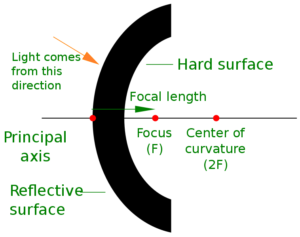Table of Contents
A diverging mirror, as well known as a convex mirror, is a curved mirror with a reflective surface that bulges toward the light source. Convex mirrors reflect light outwards and thus cannot be used to focus light. Because the focal point (F) and the centre of curvature (2F) are both imaginary points “inside” the mirror that cannot be reached, such mirrors always produce a virtual image. As a result, because the image formed by these mirrors is inside the mirror, it cannot be projected on a screen. The image is smaller than the object at first but grows larger as the object gets closer to the mirror.
Because the normal to the surface differs at each spot on the surface, a collimated (parallel) beam of light diverges (spreads out) after reflection from a convex mirror.
A “diverging mirror” is a name given to a convex mirror. Light rays diverge upon reflection due to the behaviour of the mirror. This implies that when a light ray hits the reflective surface of the convex mirror, the originally parallel light rays that form the beam deviate/diverge.

Uses of convex mirrors
A convex mirror is typically used on the passenger side of a car. In certain countries, these are labelled with the safety warning “Objects in mirror are closer than they appear” to warn drivers of the distorting effects of the convex mirror on distance perception. Convex mirrors have been preferred in vehicles because they provide an upright (not inverted), albeit diminished (smaller), image and a wider field of view due to their curved outwards shape.
Such mirrors are commonly found in the hallways of various buildings, including hospitals, hotels, schools, stores, and apartment buildings (commonly known as “hallway safety mirrors”). They have been typically mounted on a wall or ceiling where hallways intersect or make sharp turns. They are useful for people to look ahead to see if there will be any obstacles in the next hallway or after the next turn. They are often used on roads, driveways, and alleys to provide safety for motorists in areas where visibility is limited, particularly at curves and turns.
Convex mirrors are being used as a simple and useful security feature in some automated teller machines, allowing users to see what is going on behind them. Related devices are available for attaching to standard computer monitors. Convex mirrors create everything appears smaller while covering a larger surveillance area.
Oeil de Sorcière (French for “sorcerer’s eye”) round convex mirrors were a popular luxury item from the 15th century onwards and can be seen in many depictions of interiors from that time. It really was easier to make a regular curved mirror (from blown glass) than a perfectly flat one with 15th-century technology. They also were known as “bankers’ eyes” because of their wide field of vision, which was useful for security. Prominent examples in the art include Jan van Eyck’s Arnolfini Portrait and Robert Campin’s Werl Altarpiece’s left wing.
Convex mirror image
A convex mirror’s image is always virtual (rays do not actually pass through the image; their extensions do, as in a regular mirror), diminished (smaller), and upright (not inverted). As the object gets closer to the mirror, the image grows larger until it is roughly the size of the object when it touches the mirror. Even as an object moves away, the image shrinks in size and gets closer to the focus, until it is reduced to a point in the focus when the object is infinitely far away. Convex mirrors are indeed very useful because everything appears smaller in the mirror, they cover a wider field of view than a normal plane mirror, making them useful for looking at cars behind a driver’s car on the road, watching a larger area for surveillance, and so on.
FAQs
What differentiates the convex and the concave mirror?
The reflective surface of concave mirror curves inward where the reflective surface of a convex mirror bulges outward towards the source of light. A convex mirror produces an image that is smaller than the actual size of the object, whereas a concave mirror produces an image that is larger than the actual size of the object. Whenever we want to magnify the reflected image, we use a concave mirror, whereas, with a convex mirror, the size is reduced so that it fits in the mirror.
What are the properties of a convex mirror?
Because the reflective surface bulges outward in the direction of the light rays, the convex mirror is also known as a curved, diverging, or fish-eyed mirror. As a consequence, the focal point and centre of curvature are hidden behind the mirror, making them fictitious and unreachable. The produced image of the object is essentially smaller in size, virtual, and erect.



